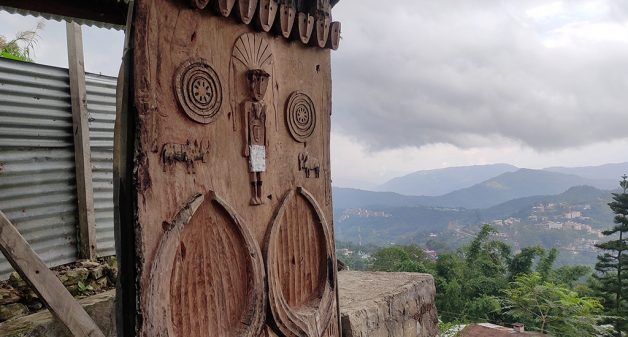
Naga tribes carve out their culture
The boldly carved wooden gates at the entrance of Naga villages once appeased ancestors. Today, the few that remain are symbols of old hopes and aspirations – a legacy many artisans are keen to conserve.

The boldly carved wooden gates at the entrance of Naga villages once appeased ancestors. Today, the few that remain are symbols of old hopes and aspirations – a legacy many artisans are keen to conserve.
Do village gates signify more than the village boundary? They do in Nagaland.
The carved wooded designs are not just artful and striking – they are steeped in meaning.
Long before the words “logo” and “branding” came into the lexicon, the Naga tribes — tribal villagers of Nagaland — were branding their territory with carved symbols of population, fruitfulness and power as a way of appeasing their forefathers.
The giant wooden gate in the Kohima village brings a smile to 78-year-old Meguo Mechulho every time he walks past it. For him the gate’s intrinsic carvings signify the rich culture of Nagaland.
“While developing a new settlement, our ancestors built such gates outside the village to seek their forefathers’ blessings,” said Mechulho, a farmer.

Several carved gates are found in Nagaland, at the entrance and exit of villages, generally built by the ethnic Angami and Chakhesangs tribes.
The set of heads on the top signifies that the village has a lot of inhabitants, the figure of a warrior standing with a spear represents the wise man. The round objects represent the sun and the moon.
“The bull’s head signifies the health of the livestock. The two protruding structures signify that the village should have a lot of lactating mothers,” said Mechulho. “The design of paddy and buffaloes symbolises the presence of ample food and livestock in the village.”
According to Mechulho, the gate in Kohima is one of the oldest in Kohima district, which is a replica made in 1969 after the original door got damaged.
Though the state government claims to restore art and culture in Nagaland, authorities said that there were no official records of these gates. The custom is believed to have started in the 18th century.

“Whenever we find damaged doors, we repair them. But shortage of funds poses a constraint. People still build them to keep the culture alive, but iron has been replacing the wooden ones,” said Adela Moa, Director of the state’s Directorate of Art and Culture.
With changing times, the practice of carving these old gates has declined. But people still have a strong connect with their traditions and many are trying to conserve them.
“Our society considers the doors holy,” said 31-year-old Mhao Aaron Odyuo, who runs The Art Village to train young artisans. “The gates were placed strategically at the entrance and exit of the villages to prevent the entry of rivals as Nagas are a warrior tribe.”
Odyuo said there were other curious customs associated with the gates too, like not being allowed to use wood from a tree that had been struck by lightning. Funerals processions are still mindful of the gates too.

“For taking the dead, a different path is used, as the dead bodies are not allowed to pass through the doors as a mark of respect,” he said.
Titus Angami, a 34-year-old documentary film maker from Kohima, has been working with 15 youths to conserve the art.
“We started restoration work in January this year and have restored two doors so far. It takes a lot of time and effort to restore them without harming the original design,” he said.
He said that the Naga tribes are superstitious about the structures and initially elders resisted the use of chisel and hammer for restoration.
“Villagers hold onto many old beliefs. They sternly told us not to work during the paddy season, fearing the wrath of our ancestors. So we worked from January till March.”
Rokovar Vihienuo, a 44-year-old Kohima-based artisan, has also been trying to conserve the art by making small souvenirs and artefacts. “The aim is to let outsiders know about our rich heritage and culture. It can also promote tourism and bring revenue,” he said.
Even young artisans are making show pieces using designs found in the doors.

“There’s still a strong demand for these artefacts both within and outside Nagaland,” said Vikuolelie Keditsu, a 27-year-old artisan.
Naga tribes have also been fixing replicas of the doors in front of their houses to continue their tradition.
Apart from the doors, villagers fixed bullhorn-like structures – locally called “kikie” – atop their houses. It is a matter of pride for the Naga tribes and has to be earned.
“One who wants a kikie has to feed the entire village. But not everyone can afford to feed the village,” said Vihienuo.
48-year-old veteran artisan Lanu Pongen – whose art is displayed in England’s Cambridge Museum – said that the government should do more to uplift the artisans. He said if the artform is to be preserved then supporting the art and modern-day artisans is vital.
“The artisans don’t earn enough after a back-breaking job for hours. They suffer from back and eye problems. And the youngsters are losing interest because of low returns,” said Pongen. “The culture will only survive if the artisans can lead a financially stable life.”
Gurvinder Singh is a journalist based in Kolkata.